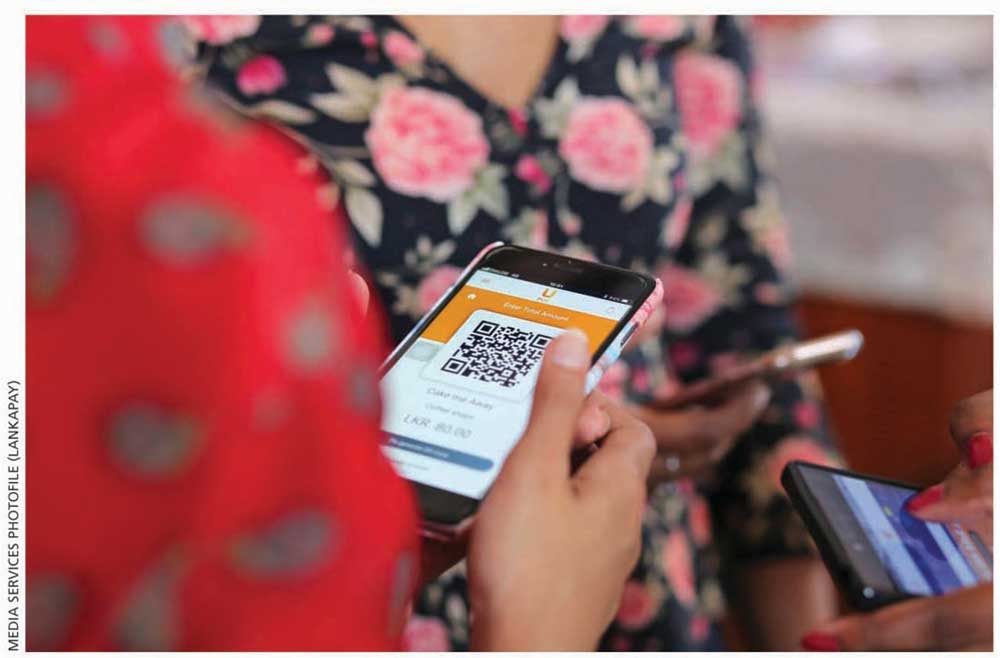LANKAPAY
 Q: LankaPay completes a decade since the launch of Common Card and Payment Switch (CCAPS). What is CCAPS and what are some milestones that have stood out during this journey?
Q: LankaPay completes a decade since the launch of Common Card and Payment Switch (CCAPS). What is CCAPS and what are some milestones that have stood out during this journey?
A: The purpose of launching CCAPS was to connect all financial institutions and banks into a common network to facilitate real-time interbank transactions. Through this initiative, we connected ATMs, enabled real-time fund transfers, and expanded into mobile payments and QR-based payments among other services.
By connecting financial institutions through technology and offering these digital financial services securely at an affordable rate, our goal was to ensure that we make these services accessible to everyone, thereby ensuring financial inclusivity. We aimed to bring together marginalised communities into the financial ecosystem and enable them to reap the benefits of financial services through technology.
We began our operations in 2002 as LankaClear to automate the interbank cheque clearing process, which was initially a very labour-intensive process. Over time, we progressed to automate the entire cheque clearing process, and became the first in South Asia and second in the world to achieve cheque clearing on a next business day basis.
With the eventual implementation of the CCAPS switch, we moved into a new dimension where we increasingly promoted digital payments. Previously, cheque clearing accounted for 70-80 percent of our income, which has since dropped to less than 20 percent by transitioning to digital transactions.
Initially, we connected all ATMs to one switch, enabling individuals to withdraw cash from another bank’s ATM. Subsequently through CCAPS, we were able to provide instant fund transfers between banks and facilitate mobile payments. We are now known as LankaPay.
Following advancements in payment infrastructure, the government invited us to build a system to facilitate online government payments. In 2017, we launched the LankaPay Government Payment Platform, which now facilitates billions of transactions monthly.
We were also the first in the country to obtain Payment Card Industry Data Security Standards (PCI DSS) certification, which is the highest security standard in the payment card sector.
LankaPay brought further convenience to businesses and citizens by introducing LankaSign, aimed at eliminating manual paper trails such as invoices and purchase orders by offering digital signatures.

Q: How has the CCAPS evolved over the past 10 years and what impact has it had on Sri Lanka’s payment landscape?
A: A key objective of CCAPS was to transition people towards digital commerce and thereby provide convenience. Platforms like JustPay, a real-time fund transfer system enabling instantaneous mobile payments across different banks, have made this transition possible. And certain fintech apps facilitate one touch mobile reloads through this system, which was beneficial during the pandemic.
Banks and fintech companies offer solutions for various services, leveraging the infrastructure that we’ve established. This infrastructure enables the creation of services that enhance convenience and attract more individuals to digital transactions.
According to the Central Bank of Sri Lanka’s ‘Payments Bulletin – Third Quarter 2023,’ real-time payments and interbank instant payments accounted for 37 percent of the country’s GDP (Rs. 10 trillion). Total transactions across all LankaPay systems exceeded 24 trillion rupees last year, which is equivalent to Sri Lanka’s GDP.
This highlights the significant impact these systems have, which is continuously growing. The adoption is primarily attributed to LankaPay’s facilitation, allowing banks, finance companies and fintechs to offer diverse services and convenience for customers to embrace digital transactions.
Through various technologies, we’ve bridged this gap and are moving toward bringing the entire ecosystem onto a digital platform.
Q: What strategies and projects are focussed on to encourage the adoption of digital transactions?
A: We’ve analysed different scenarios regarding online and on premise payments. Online payments occur from anywhere while on premise payments are made at physical locations. LankaPay has attempted to address various market gaps, utilising technology to enhance user convenience.
JustPay was introduced primarily for online payments, enabling individuals to make payments to anyone from their mobile devices. For on premise payments, we introduced LankaQR code. We’ve also facilitated government payments, addressing the challenge of individuals having to visit offices to make payments.
Our strategy revolves around simplifying the user experience for digital transactions to be more convenient than using cash. Individuals with smartphones are more likely to engage in digital payments so we aim to onboard them first. Recent market research indicates a 60-65 percent smartphone penetration rate, not only in Colombo but across the country, presenting significant market potential.
Although cash usage remains high with Rs. 1.1 trillion in circulation, 75 percent (835 billion rupees) is held by the public and not in banks, according to the Central Bank’s Payments Bulletin – Third Quarter 2023. Encouraging more cash to enter the banking system can facilitate more lending opportunities and interest generation, providing better access to credit.
To provide a seamless experience, we curated PayMe, enabling users to initiate payment requests conveniently. Our road map includes similar services to encourage digital adoption and address existing technology gaps in the market, benefitting consumers, banks, finance companies and fintechs.

Q: How has the adoption of digital payment solutions impacted local businesses – especially SMEs?
A: LankaQR was introduced to the ecosystem to serve this purpose along with other payment instruments.
In terms of online payments, we’ve witnessed significant growth over the past two years and in addition, banks have acquired more than 350,000 LankaQR merchants.
We will soon launch a campaign to raise awareness among merchants and consumers to encourage adoption. Although COVID-19 accelerated the shift towards digital payments, adoption especially in on premise transactions is still evolving. Despite significant growth in the past few years, digital transactions in the retail space remain relatively small in overall numbers.
With government payments to local bodies in the process of being digitalised, the public will begin to recognise its value. It’s crucial to integrate all ecosystems and make them part of our portfolio. Financial inclusivity shouldn’t be limited to the Western Province – it should extend to rural areas and beyond. Everyone regardless of location should have access to these services.
Q: What sort of impact does LankaPay have on the overall economic growth of Sri Lanka and secure transactions?
A: A rule of thumb regarding the cost of cash is that it encompasses printing, distribution and security measures, estimated to be roughly about 1.5 percent of the GDP for an economy. To put this in perspective, the cost of education in Sri Lanka amounts to only two percent of GDP.
This means that we’re essentially wasting 1.5 percent of GDP to maintain cash, highlighting substantial expenditure. If we can transition 30 percent of cash transactions into digital payments, we could potentially save 0.5 percent of GDP that could be used for social benefit projects.
In dealing with digital transactions across borders, digital signatures on documents are imperative. LankaSign facilitates the acceptance of digital signatures internationally, recognising that financial transactions are merely one aspect of a broader requirement.
Regarding the security of digital transactions, we assure that digital transactions within banks are highly secure, and the PCI DSS certification demonstrates our commitment to safeguarding information transferred between our systems and banks.
Accounts are often compromised through social engineering where individuals inadvertently share OTPs (one-time passwords), compromising the safety of bank accounts. It’s important to note that system glitches rarely lead to such fraud. Most instances occur due to ignorance and lack of awareness – especially when individuals share either their ATM PINs or OTPs with third parties.

Q: What’s LankaPay’s vision for the future of digital payments?
A: Our primary focus is on reaching the masses and we’re also forging connections with international players. We’ve successfully linked with JCB of Japan, UnionPay of China, the National Payments Corporation of India (NPCI) of India and we’re on the verge of integrating Alipay+. Additionally, we’re collaborating with Nepal.
LankaPay is an integral part of the Asian payment network, encompassing 13 payment networks across 12 countries in the Asia-Pacific region to lower the cost of transactions across these countries, facilitating ATM transactions, fund transfers and QR payments, and more.
We’re working towards making cross-border transactions seamless, cost-effective, faster and secure, while also promoting financial inclusivity and attracting much needed foreign exchange to the country.
– Compiled by Tamara Rebeira
COMPANY DETAILS
Telephone: 2356900 | Email: info@lankapay.net | Website: www.lankapay.net




